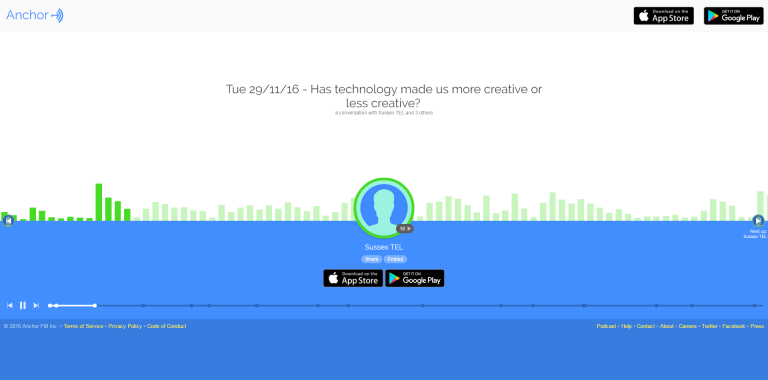Over the last few weeks I’ve seen quite a bit of noise across the sector about a new broadcast communication app (for iOS and Android) called Anchor FM (or just Anchor, according to their main website). The idea behind the app is to be able to post a short (up to 2 minute) audio clip that can be broadcast via normal social media platforms, embedding in blogs and sites etc. That clip can be listened to and then responded to via the app. Responses are added to the original recording in a timeline format, allowing the listener to skip forwards and back to listen to different responses, and record their own responses, and so on.

This approach something of a mix of podcasting, forum discussion and Twitter, with the benefits and disadvantages that come with each of these approaches. When you combine these, do you end up with something that is a bit of fun but only finds pockets of use, or will Anchor provide the staying power that can position it amongst those core pillars of educational technology?
Pros and Cons
So let’s take a look at where Anchor’s strengths really lie.
Top of the list is simplicity – the process for recording is both simple and familiar. Push the record button then raise the phone to your ear as if you were making a call – Anchor won’t start properly recording until that happens. (If you prefer to use an external microphone, you can use the record button to make the recording start – straight-forward instructions are all given on-screen.) You then have two minutes to make your recording. At one minute fifty the screen turns red to warn you that your recording (or “wave”) is nearly out of time. When you stop your recording, or at the end of the two minutes, you are given the option to preview your wave and either publish or delete the whole thing.
Your new wave can then be published and shared – Twitter and Facebook sharing is built-in, as well as embedding Twitter features (hashtags, mentions etc) into the title of the wave. You can also share your wave with known contacts (whether they have an Anchor account or not).
Listening back to waves are simple too – click play and listen. If you are listening through the app, you can click to record a response (responses appear to be limited to one minute). Responses are automatically played in chronological order, and with a nice little blingy noise (that’s a technical term) in between each one so you know you are listening to a new response. See for yourself…
The two minute limit is very akin to Twitter’s 140 characters, but of course you can do a lot more in two minutes of audio than you ever could in a single tweet, and the response system is very simple – there’s no way to branch your responses into separate discussions, for example. This is a mixed blessing, as potentially a conversation could be derailed by two or more responders wanting to discuss different aspects of the original post. Conversely, if the discussion follows a particular single thread it becomes very easy to follow through and engage in the conversation, or to divert the thread if the original discussion appears to have wrapped up.
By including the user’s profile image within the timeline, you can quickly jump to particular responses within the wave so navigating around the conversation is fairly easy (although could become complicated if the same users respond many times within the one wave).
One of the biggest disadvantages for me is the requirement to use the app to record. I could be listening to a wave embedded on a blog through my desktop browser, but if I want to reply I need to somehow find that wave in the app. Currently finding a particular wave that you’ve seen elsewhere is not all that easy, except by following the user who posted it and scrolling through their list. It would be far more useful if I could also record through the web interface, but perhaps that might appear in a future update.
The other big issue when it comes to using this in an educational environment, particularly HE in the UK, is the need for a quiet-ish environment in which to listen and, particularly, record. It’s difficult in a 21st century University to find a quiet space to work in at the best of times, but particularly difficult if you want to record audio. Obviously, this is not a limitation of Anchor per se, but of audio technologies in general, but I think it is particularly notable with Anchor given that you are likely to make lots of short recordings spread across a long period of time. Compare that with booking a quiet room for an hour to make a podcast, which is something you can plan for. How usable would Anchor be long-term in a noisy open-plan academic office?
There is great potential in using it with students, particularly those who are studying at a distance, or in placement where access to mainstream technology might be limited. A student could lurk easily, taking a few moments between jobs to catch up on a wave or two, and can respond quickly without having to jump through hoops.
Verdict
I really rather like the idea of Anchor, and I plan to use it for events and such to see how much people will engage through it. It has all the core ideals that could make it a hit with educators – simple to use, easy to access, functional without complexity, and a really clean way to engage learners effectively. Whether it will become a mainstay in the education sector, I’m yet to be convinced, but I think I’d like it to be.
But what do you think? Let me know in the comments below or, even better, respond to my wave on the matter at https://anchor.fm/w/a53176
